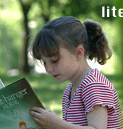|
Teaching readers to review and use the knowledge gained:
After-reading strategies
After-reading or post- reading strategies are the actions readers
use to review what they have read, to integrate what they have read
into an overall understanding, to reflect on its interest or value
to them, to reflect on what they did to help them read and to add
it to what they know. These actions can be used following reading
aloud or silently.
This is the 'value adding' aspect of the reading. The various types
of after- or post- reading strategies are as follows.
Show comprehension: Readers can show their comprehension
of the text they have read
- in cloze activities.
- by re-telling or paraphrasing what has been read.
- by drawing a poster, pictures or by acting out (following a
recipe etc.).
- by writing questions for the print read.
- by answering comprehension questions. Types of questions include
- 'Right there' questions: for answers that were explicitly
stated in the text,
- Think and search questions: for answers that needed to be
inferred from the text,
- On my own questions: for answers that drew on readers' background
knowledge.
Questions can be classified in different ways, for example:
- recall information directly from the text, for example,
"What colour are fire engines?"
- reorganise, paraphrase, translate, analyse, synthesise or
organise explicitly stated text.
- go beyond the information given in the text, interpret it;
"Why do you think fire engines are painted red, rather
than brown or blue?"
- evaluate the ideas in terms of an external criterion, for
example, "Do you think that it is a good idea to paint
fire engines red?"
- express an emotive response to the content, for example
"Did you get excited as you read the story about fire engines?"
Readers can show comprehension at each level of text processing,
for example,
- word level; use context to decide word meanings, why particular
words used.
- sentence level; answer sentence level questions, paraphrase
sentences.
- conceptual level; infer, anticipate, suggest alternative outcomes,
apply ideas in other contexts.
- topic level; write or invent a similar text , extend the theme,
draw a comic strip of the main events, invent a play based on
the theme, play games described in it, etc.
Respond emotionally to the print; How did I like the
story? How did I feel while I was reading it? What made me feel
that way? Would I like to read it again? Were there words or things
that happened, that made me feel happy, excited, or worried?
Review the reading 'actions' that worked while reading;
What reading actions worked for me? What did I do to work out
this word? Did making a picture help here? Students share the
strategies that worked and list them, adding new ones.
Discuss why the material was written; To amuse us, to
make us feel happy, sad or to scare us, to teach us something, to
let us know how other people live? To tell us about something that
happened, to give us ideas about things that we could do? The
readers support opinions using the print; What helped to make
me feel sad?
Identify key ideas and store them in long-term memory; the
student needs to learn how to change or add to her/his knowledge
base in the content areas. They can:
- describe the main ideas as concisely as possible,
- link these ideas to the existing knowledge base; "What do
these ideas remind me of? How are they like / different from things
I've already learnt?"
- draw a picture of the main ideas, or use a concrete model of
them,
- draw a semantic map of the ideas,
- describe when the ideas might be used in the future.
Add new words and new meanings to their vocabulary:
discuss new words, guess their meanings using the context of the
text, use them in sentences, check the guess against dictionary
meanings, put them in semantic categories; What new words did
I meet in the passage? What could __ mean? What can I guess about
its meaning? Why did the writer use this word? What other words
could have been used? What are opposites of the word? When might
I use this word in the future?
|

